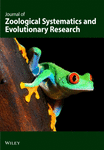Zur Phylogenie der Panorpiden Europas (Insecta, Mecoptera)
Abstract
Zusammenfassung
Die phylogenetischen Beziehungen der europäischen und mit diesen verwandten außereuro-päischen Panorpa-Arten werden diskutiert. Untersdiieden werden übergeordnet die Panorpa-alpina-, P.-connexa- und P.-communis-Gruppe, die durch abgeleitete Merkmale jeweils ah monophyletisch ausgewiesen sind.
Innerhalb der communis-Gruppe bleibt die genaue systematisdie Stellung von P. communis + vulgaris, der aspoecki-Gruppe und P. nigrirostris nodi ungeklart. In der cognata-Gruppe ist P. meridionalis als Sdiwesterart von P. annexa + cognata aufgefafit; allerdings ist die Stellung von P. sibirica nodi unbekannt, die wahrsdieinlidi ebenfalls der cognata-Gruppe angehort. Im Fehlen von Terminalsdiuppen sind P. germanica+lacedaemonia plesiomorpher als alle Ubrigen Species der communis-Gruppe, sie werden diesen als Sdiwestergruppe gegenübergestellt. Nicht sidier ist, weldier dieser beiden großen Teilgruppen P. hy-rida zugeordnet werden muß.
P. rufostigma, die alpina- und die connexa-Gruppe gehören der communis-Gruppe nicht an. Ihre phylogenetischen Beziehungen sind nodi nicht bekannt.
Summary
On the Phytogeny of the European Panorpidae (Insecta, Mecoptera)
The relationships between the European Panorpidae and their allies are discussed. Three groups can be distinguished: the Panorpa alpina-, the P. connexa- and the P. communis-group; each being monophyletic (sensu HENNIG) as indicated by synapomorphous structures.
Within the communis-group, the systematic positions of P. communis+vulgaris, the aspoecki-group and P. nigrirostris are not clarified. The cognata-group encloses P. meridionalis, and, being the sistergroup of this species, P. cognata + annexa. The position of P. sibirica, probably à further member of the cognata-group, is not known. With respect to the absence of the so-called “Terminalsdiuppe” in the male genitalia of P. germanica + lacedaemonia, they are more plesiomorphous than all of the resting species of the communis-group; the former being the sister-group of the latter. It is not yet clear into which of these two large subgroups P. hybrida should be placed.
P. rufostigma, the alpina- and the connexa-groups do not belong to the communis-group. Their closest allies remain uncertain.




